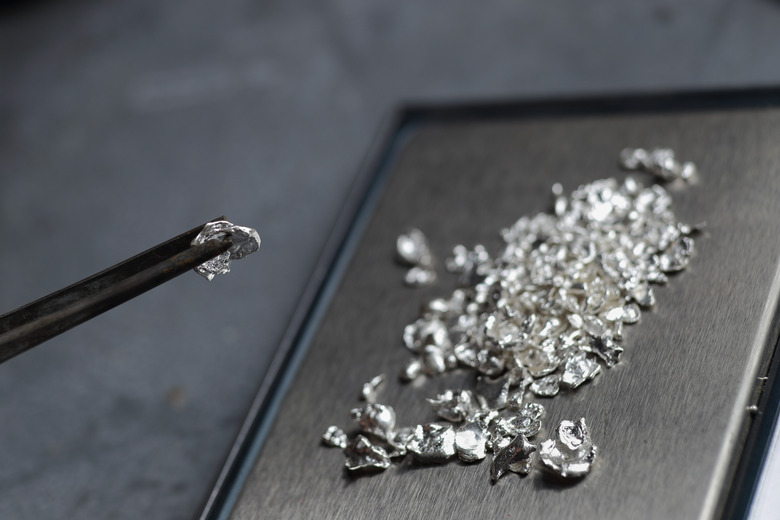Which Metals Are The Heaviest?
When you talk about how heavy a metal is, you are really talking about how dense it is. Density is a measurement of how tightly matter is packed together. When you look into the density of different metals, you may be surprised. You may think of lead as being very dense, but many other metals have a far greater density.
TL;DR (Too Long; Didn't Read)
Osmium and iridium are the densest metals in the world, but relative atomic mass is another way to measure "weight." The heaviest metals in terms of relative atomic mass are plutonium and uranium.
Density vs. Atomic Weight
Density vs. Atomic Weight
When talking about heavy metals, you need to distinguish between density and atomic weight. The density of a material is mass per unit volume. Density is measured in kilograms per cubic meter (kg/m3) or grams per cubic cm (g/cm3). Density affects how different materials interact. For example, many types of metal sink in water because the metal has a higher density (i.e., it is more dense) than water.
On the other hand, atomic weight is the average mass of atoms of an element. A unit of atomic weight, which is dimensionless, is based on one-twelfth (0.0833) of the weight of a carbon-12 atom in its ground state. In other words, a carbon-12 atom is assigned 12 atomic mass units. Atomic weight is more commonly known as relative atomic mass to avoid confusion because atomic mass isn't exactly the same thing as atomic weight, and "weight" implies a force exerted in a gravitational field, measured in units of force such as newtons.
Most Dense Metals
Most Dense Metals
Osmium and iridium are the most dense metals. In other words, their atoms are packed together more tightly in solid form than other metals. With a density of 22.6 g/cm3 and 22.4 g/cm3 respectively, osmium and iridium are about twice as dense as lead, which has a density of 11.3 g/cm3. Osmium and iridium were both discovered by English chemist Smithson Tennant in 1803. Osmium is rarely used in its pure form and mostly mixed with other dense metals like platinum to create very hard, strong surgical equipment. Iridium is mainly used as a hardening agent for platinum alloys for equipment that has to withstand high temperatures. Platinum measures a density of 21.45 g/cm3. It does not mix easily with other elements and in its pure form is used in catalytic converters, laboratory equipment, dentistry equipment and jewelry.
Heaviest Metal by Relative Atomic Mass
Heaviest Metal by Relative Atomic Mass
The heaviest naturally occurring element is plutonium (atomic number 94, relative atomic mass 244.0). Other heavy metals in terms of relative atomic mass are uranium (atomic number 92, relative atomic mass 238.0289), radium (atomic number 88, relative atomic mass 226.0254) and radon (atomic number 86, relative atomic mass 222.0). Oganesson (atomic number 118) is the heaviest element on the periodic table, but it is a synthetic element that can't be observed in nature. Lithium (atomic number 3, relative atomic mass 6.941) is the lightest metal in terms of relative atomic mass.
Heavy Metal Definition
Heavy Metal Definition
The correct definition of a heavy metal actually has nothing to do with relative atomic mass or density. Any toxic metal may be called a heavy metal, including lead, mercury, arsenic, cadmium, cesium, chromium, selenium, silver, nickel, copper, aluminum, molybdenum, strontium, uranium, cobalt, zinc and manganese, all of which exist naturally on Earth.
References
Cite This Article
MLA
Gillespie, Claire. "Which Metals Are The Heaviest?" sciencing.com, https://www.sciencing.com/metals-heaviest-8751708/. 10 April 2018.
APA
Gillespie, Claire. (2018, April 10). Which Metals Are The Heaviest?. sciencing.com. Retrieved from https://www.sciencing.com/metals-heaviest-8751708/
Chicago
Gillespie, Claire. Which Metals Are The Heaviest? last modified March 24, 2022. https://www.sciencing.com/metals-heaviest-8751708/
